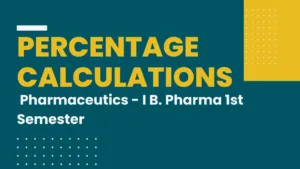Percentage calculations

Objective
At the end of this lecture, student will be able to:
• Calculate and convert percentage values into amounts that can be weighed or measured
• Calculate the quantities of different ingredients in a prescription when relative percentages
are given
Percentage calculations
Introduction
• Many prescriptions received in pharmacy have active ingredients expressed as percentage strength
• Percentage values in a prescription should be changed to amounts
– That can be weighed
– Those which can be measured
Types of Percent
• W/W percent or Weight/Weight percent: Determining the weight of a substance concerning the total weight, crucial in solid dosage forms.
• W/V percent or Weight/Volume percent: Measuring the weight of a substance in a given volume, a common method in liquid formulations.
• V/V percent or volume/volume percent: Expressing the volume of one component in relation to the total volume, vital in liquid-to-liquid formulations.
• When type of percent is not stated,
– Dry ingredients in a dry preparation are percent W/W
– Dry ingredients in a liquid are percent W/V
– A liquid in a liquid are percent V/V
Examples of pharmaceutical dosage forms in which the active ingredient is often calculated and expressed on percentage basis
Percentage basis | Examples of dosage forms |
Weight-in-volume | Solutions (ophthalmic, nasal, otic, topical, large-volume |
Volume-in-volume | Aromatic waters, topical solutions, emulsions |
Weight-in-weight | Ointment, creams and gels |
Percentage Calculations Application in Drug Formulation
A. Role in Active Ingredient Concentrations
Percentage calculations guide pharmacists in achieving precise concentrations of active pharmaceutical ingredients (APIs).
B. Ensuring Accuracy in Dosage Forms
1. Tablets
Percentage calculations guarantee the uniform distribution of active ingredients in tablet formulations.
2. Liquid Medications
Accurate percentage calculations are essential for formulating liquid medications with consistent potency.
3. Topical Formulations
In dermatological preparations, percentage calculations ensure the desired concentration of APIs for optimal therapeutic outcomes.
Solving percentage problems
IF no. of parts / 100 = THEN Amount of solute needed / Total volume or weight of the product
Example:
How many grams of zinc oxide are needed to make 240 grams of a 4% (w/w) zinc oxide ointment?
IF
4 g ZnO / 100 g Oint = THEN X g ZnO / 240 g
X = 4 X 240 / 100 = 9.6 g
Practice problems
• How many milliliters of a 5% (w/v) boric acid solution can be made from 20 grams of boric acid?
• How many milliliters of paraldehyde are needed to make 20 ml of a 10% (v/v) paraldehyde solution?
• How many grams of ephedrine sulfate are needed to make 120 ml of a 2% (w/v) ephedrine sulphate solution?
• How many grams of zinc oxide are needed to make 120 grams of 20% zinc oxide paste?
• How many grams of potassium permanganate are required to compound the following prescription:
Potassium permanganate 0.02%
Distilled water q.s. to 240 ml
• How many grams of holocaine hydrochloride and how many grams of chlorobutanol are needed to compound this prescription?
Holocaine hydrochloride ½%
Chlorobutanol 1/3%
Distilled water q.s. to 60 ml
• If 5 g of a chemical is dissolved in enough water to make the preparation measure one litre, what is the percentage strength of the solution?
• How many milliliters of a 0.02% W/V solution can be made from 2.5 g of a chemical?
• Normal saline solution contains 0.9% W/V NaCl. How many grams of sodium chloride should be used to make 1.5 liters of normal saline?
• How many grams of glucose will be required to prepare 10 litres of 2.5% solution?
• An injection contains 50 ml of pentobarbital sodium in each ml of the solution. What is the percentage of the final solution?
• How many grams of sucrose must be dissolved in 475 ml of water to form a 65% W/V solution?
• An ear drop formula contains 54 mg of antipyrine and 14 mg of benzocaine in each ml of the solution. Calculate the percentage strength of each ingredient?
Summary
• Different percent preparations – %W/W, %W/V, %V/V
• Solving problems related to percentage calculations
Also, Visit:
B. Pharma Notes | B. Pharma Notes | Study material Bachelor of Pharmacy pdf